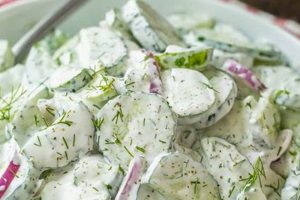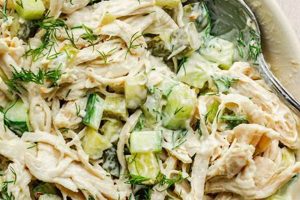A health-conscious approach to this classic dish emphasizes lean protein, whole foods, and minimal processed ingredients. Typically, such recipes utilize fresh, unprocessed chicken breast, combined with vegetables like celery, onion, and grapes, and dressed with a light, flavorful sauce, often based on Greek yogurt, avocado, or a vinaigrette, rather than mayonnaise. These variations prioritize natural flavors and nutritional value over convenience or richness.
This culinary trend reflects a broader dietary shift towards wholesome eating, emphasizing nutrient density and minimizing additives. By selecting fresh, whole-food ingredients, individuals can control the quality and quantity of fats, sugars, and sodium in their meals. This mindful approach can contribute to improved overall health and well-being, supporting weight management, boosting energy levels, and enhancing digestion. While traditional versions may feature heavier dressings and processed additions, contemporary interpretations prioritize fresh ingredients and balanced flavor profiles, making the dish suitable for various dietary preferences.
The following sections will delve into specific ingredient choices, preparation techniques, and variations that exemplify this healthful approach to chicken salad. Readers can expect practical guidance for crafting their own nutritious and delicious versions, along with suggestions for customizing flavors and accommodating dietary needs. From classic to innovative flavor combinations, the exploration promises to inspire culinary creativity while supporting health-conscious choices.
Tips for Creating a Healthier Chicken Salad
The following tips offer guidance on preparing a nutritious and flavorful chicken salad emphasizing fresh ingredients and mindful preparation techniques.
Tip 1: Prioritize lean protein. Opting for skinless, boneless chicken breast ensures a lean protein source, reducing overall fat content. Poaching or grilling the chicken enhances its natural flavor without adding unnecessary oils or fats.
Tip 2: Embrace fresh produce. Incorporating a variety of fresh vegetables adds texture, flavor, and essential nutrients. Celery, onion, bell peppers, and grapes offer classic combinations, while shredded carrots, chopped apples, or dried cranberries provide interesting variations.
Tip 3: Reimagine the dressing. Traditional mayonnaise-based dressings can be replaced with healthier alternatives. Greek yogurt, mashed avocado, or a light vinaigrette offer creamy textures and flavorful profiles while reducing saturated fat and increasing nutritional value.
Tip 4: Enhance flavors naturally. Fresh herbs and spices add depth and complexity without relying on excessive salt or processed seasonings. Dill, parsley, chives, lemon zest, and black pepper create vibrant flavor combinations.
Tip 5: Mindful ingredient preparation. Properly chopping ingredients into uniform sizes ensures even distribution of flavors and textures. Thoroughly draining excess liquid from ingredients like yogurt or canned chicken prevents a watery consistency.
Tip 6: Consider healthy add-ins. Nuts and seeds provide healthy fats, protein, and fiber, adding satisfying crunch and nutritional value. Almonds, walnuts, pumpkin seeds, or sunflower seeds offer excellent choices.
Tip 7: Adjust seasonings to taste. Taste and adjust seasonings throughout the preparation process. Start with small amounts of salt and pepper, gradually adding more until the desired flavor balance is achieved.
By following these tips, one can create a chicken salad that is both delicious and nutritious, supporting a health-conscious approach to meal preparation without sacrificing flavor or satisfaction.
These guidelines provide a foundation for crafting a personalized chicken salad experience, offering flexibility and customization while promoting balanced nutrition. The following section provides concluding thoughts and encourages further exploration of this versatile dish.
1. Lean Protein Source
Lean protein forms the foundation of a clean chicken salad recipe, contributing significantly to its nutritional value and overall health benefits. Selecting the appropriate protein source is crucial for achieving the desired balance of flavor, texture, and dietary goals. This section explores the importance of lean protein and its impact on creating a wholesome and satisfying dish.
- Chicken Breast:
Chicken breast, particularly skinless and boneless, stands as the quintessential lean protein choice for chicken salad. Its mild flavor provides a versatile canvas for various flavor combinations, while its low fat content aligns with the principles of clean eating. Poaching, grilling, or baking the chicken breast preserves its leanness and enhances its natural flavors.
- Turkey Breast:
Turkey breast offers a lean alternative to chicken, delivering a slightly different flavor profile and nutritional composition. Like chicken breast, it can be prepared through various methods to optimize its texture and flavor while maintaining its lean protein content. This option caters to individuals seeking variety or specific dietary preferences.
- Plant-Based Alternatives:
For those following a vegetarian or vegan diet, plant-based protein sources provide suitable alternatives. Products like chickpeas, lentils, or jackfruit offer distinct textures and flavors, expanding the possibilities for creating clean, plant-based chicken salad variations. These options introduce diverse nutritional benefits and cater to a wider range of dietary needs.
- Impact on Satiety and Health:
The inclusion of lean protein in chicken salad significantly contributes to satiety, promoting a feeling of fullness and reducing the likelihood of overeating. Protein plays a vital role in muscle maintenance and repair, supporting overall health and well-being. Choosing lean sources minimizes unhealthy fats and maximizes the nutritional benefits of the dish, aligning with the core principles of a clean chicken salad recipe.
The selection of a lean protein source directly impacts the nutritional profile and culinary experience of a clean chicken salad recipe. By prioritizing lean protein, individuals can create a dish that is both satisfying and health-conscious, supporting their dietary goals while enjoying a flavorful and versatile meal.
2. Fresh, Whole Ingredients
The cornerstone of a clean chicken salad recipe lies in the utilization of fresh, whole ingredients. This emphasis on unprocessed, natural components distinguishes it from conventional recipes that may incorporate processed meats, canned vegetables, or pre-made dressings. Fresh ingredients contribute significantly to both the nutritional value and the overall flavor profile of the dish. A clean chicken salad recipe prioritizes ingredients like freshly cooked chicken breast, crisp celery, vibrant onions, and ripe grapes. These ingredients, unburdened by additives or preservatives, deliver superior taste and nutritional density compared to their processed counterparts.
The impact of fresh ingredients extends beyond flavor and nutrition. Using whole foods minimizes exposure to excess sodium, unhealthy fats, and artificial additives often found in processed alternatives. This focus on natural components aligns with a health-conscious approach to eating, promoting overall well-being. For example, freshly chopped celery provides fiber and vitamins, while incorporating grapes introduces natural sweetness and antioxidants. This approach allows individuals to control the quality and composition of their meals, fostering a deeper understanding of the food they consume.
In conclusion, the emphasis on fresh, whole ingredients within a clean chicken salad recipe is paramount. This commitment to unprocessed, natural components elevates the nutritional value, enhances the flavor profile, and promotes a more health-conscious dietary approach. The conscious selection of fresh ingredients empowers individuals to create a dish that nourishes both body and palate, aligning with the principles of clean eating and fostering a deeper connection to the food consumed. This fundamental principle underlies the essence of a truly clean and wholesome chicken salad experience.
3. Light, Flavorful Dressing
Dressing selection significantly impacts the overall healthfulness and taste profile of a clean chicken salad recipe. Traditional mayonnaise-heavy dressings often contribute excessive saturated fat and calories, detracting from the nutritional benefits of the other ingredients. A light, flavorful dressing enhances the dish without compromising its health-conscious nature. This approach prioritizes flavor complexity and ingredient quality over richness derived from heavy fats and processed additives.
- Greek Yogurt Base:
Greek yogurt offers a creamy, tangy base for chicken salad dressing, providing a substantial protein boost while reducing fat content compared to mayonnaise. Its versatility allows for seamless integration with various herbs, spices, and citrus juices, creating a customizable flavor profile. This lighter base complements the fresh ingredients, allowing their natural flavors to shine.
- Avocado-Based Dressings:
Mashed avocado contributes healthy fats, creamy texture, and a subtle, nuanced flavor to chicken salad dressings. Its natural richness eliminates the need for excessive oils or mayonnaise, aligning with the clean eating philosophy. Avocado also provides essential nutrients and antioxidants, further enhancing the nutritional value of the salad.
- Vinaigrettes:
Light vinaigrettes, crafted from quality olive oil, vinegar, and herbs, offer a refreshing and vibrant alternative to creamy dressings. They impart bright, tangy notes that complement the savory chicken and fresh vegetables. The versatility of vinaigrettes allows for endless customization with ingredients like lemon juice, Dijon mustard, or fresh herbs, creating unique flavor profiles.
- Emphasis on Fresh Herbs and Spices:
Regardless of the base, fresh herbs and spices play a vital role in creating a light yet flavorful dressing. Dill, parsley, chives, cilantro, and mint introduce aromatic complexity, while spices like black pepper, paprika, or cumin add depth and warmth. These natural flavor enhancers eliminate the need for excessive salt or processed seasonings, contributing to a cleaner, more health-conscious approach to flavor development.
The careful selection of a light, flavorful dressing elevates a clean chicken salad recipe from simply healthy to truly delicious. By prioritizing fresh, wholesome ingredients and mindful flavor combinations, individuals can create a dish that satisfies both nutritional and culinary desires. This approach underscores the core principle of clean eating: that healthy food can and should be enjoyable and flavorful. The dressing becomes an integral component, enhancing the overall experience rather than masking the natural flavors of the fresh ingredients.
4. Minimal processed additions
Minimal processed additions represent a cornerstone of the clean chicken salad recipe concept. This principle centers on minimizing or eliminating ingredients subjected to extensive industrial processing, such as pre-packaged deli meats, canned vegetables with added sodium, or commercially produced dressings containing artificial preservatives and flavors. The rationale behind this approach stems from the desire to prioritize whole, unadulterated foods, maximizing nutrient density while minimizing exposure to potentially harmful additives. Processed foods often contain elevated levels of sodium, unhealthy fats, and artificial ingredients that can detract from overall health and well-being. A clean chicken salad recipe, conversely, emphasizes fresh, minimally processed ingredients like freshly cooked chicken breast, chopped vegetables, and homemade dressings using natural ingredients. This commitment to ingredient purity ensures greater control over the nutritional profile and flavor composition of the final dish.
Consider the difference between using freshly roasted chicken breast versus pre-packaged deli chicken. The former allows control over seasoning and preparation methods, ensuring a leaner, more flavorful protein source. The latter, while convenient, may contain added sodium, preservatives, and other additives that detract from the clean eating philosophy. Similarly, opting for fresh vegetables over canned varieties reduces sodium intake and provides a crisper texture and brighter flavor. Homemade dressings, using ingredients like Greek yogurt, olive oil, and fresh herbs, allow for customization and eliminate the need for processed emulsifiers, stabilizers, and artificial flavors commonly found in commercial dressings. These practical examples illustrate the tangible benefits of minimizing processed additions in achieving a truly clean and wholesome chicken salad.
The pursuit of a clean chicken salad recipe inherently involves a conscious effort to minimize processed additions. This approach not only enhances nutritional value and flavor but also fosters a deeper understanding of the food consumed. By prioritizing whole, unprocessed ingredients, individuals gain greater control over their dietary choices and contribute to a more health-conscious lifestyle. While convenience often dictates the use of processed foods, the clean eating philosophy emphasizes the long-term benefits of selecting fresh, natural ingredients. This understanding highlights the importance of minimal processed additions as a defining characteristic of a clean chicken salad recipe and its broader implications for health and well-being.
5. Nutrient-Dense Choices
Nutrient density forms a core principle within the clean chicken salad recipe framework. This concept emphasizes maximizing the nutritional value of each ingredient, prioritizing foods rich in vitamins, minerals, antioxidants, and other beneficial compounds relative to their caloric content. Selecting nutrient-dense ingredients ensures the recipe contributes positively to overall health and well-being, aligning with the broader goals of clean eating. This section explores the importance of nutrient-dense choices and their impact on crafting a truly wholesome and nourishing chicken salad.
- Emphasis on Whole Foods:
Nutrient density inherently favors whole, unprocessed foods over refined or processed alternatives. Fresh vegetables like leafy greens, colorful bell peppers, and antioxidant-rich berries offer a wealth of micronutrients and fiber. Choosing whole grains over refined grains provides additional fiber and essential nutrients. In a clean chicken salad recipe, this translates to prioritizing fresh produce and avoiding processed ingredients, maximizing the nutritional impact of each component.
- Lean Protein Selection:
Lean protein sources, such as chicken breast or fish, contribute essential amino acids without excessive saturated fat. These proteins support muscle growth and repair while keeping the overall calorie count in check. Opting for lean protein aligns with the nutrient-dense philosophy, maximizing the health benefits while minimizing less desirable components.
- Healthy Fat Incorporation:
Not all fats are created equal. Nutrient-dense choices emphasize healthy fats, such as those found in avocados, nuts, and seeds. These fats provide essential fatty acids, support cell function, and contribute to satiety. Incorporating these healthy fats into a clean chicken salad recipe adds nutritional value and enhances flavor and texture.
- Minimizing Empty Calories:
Nutrient density inherently discourages empty caloriescalories derived from foods lacking significant nutritional value. Sugary drinks, processed snacks, and excessive refined carbohydrates contribute calories without providing substantial vitamins, minerals, or other beneficial compounds. A clean chicken salad recipe, by focusing on whole, unprocessed foods, naturally minimizes empty calories, maximizing the nutritional return on each calorie consumed.
Nutrient-dense choices represent a critical component of a clean chicken salad recipe. By prioritizing foods rich in vitamins, minerals, and other essential nutrients, individuals can transform a simple salad into a powerhouse of nutrition. This approach aligns with the broader philosophy of clean eating, emphasizing the importance of food as fuel for overall health and well-being. The conscious selection of nutrient-dense ingredients elevates the chicken salad beyond a mere meal, transforming it into a vehicle for nourishing the body from the inside out. This understanding underscores the vital connection between nutrient-dense choices and the creation of a truly clean and wholesome chicken salad.
6. Balanced Flavor Profiles
Balanced flavor profiles are integral to a successful clean chicken salad recipe. The concept extends beyond mere palatability; it represents a deliberate approach to flavor layering, ensuring no single element dominates the overall taste experience. This balance allows the inherent flavors of fresh, high-quality ingredients to shine through, a hallmark of clean eating. A harmonious blend of tastessweet, sour, salty, savory, and umamicreates a more complex and satisfying culinary experience, eliminating the need for excessive salt, sugar, or artificial flavor enhancers often found in less health-conscious recipes. For example, the slight sweetness of grapes can balance the savory notes of chicken and the tanginess of a Greek yogurt dressing, while the crunch of celery adds textural contrast, further enhancing the overall sensory experience. This multifaceted approach to flavor ensures the final dish is not only nutritious but also enjoyable, promoting long-term adherence to a clean eating regimen.
Achieving balanced flavor profiles in a clean chicken salad recipe requires careful ingredient selection and preparation. Fresh herbs, like dill or chives, can add brightness and complexity, while spices such as black pepper or paprika introduce subtle warmth and depth. Acidity from lemon juice or vinegar balances richness from healthy fats like avocado or nuts. Consider the interplay between the creamy texture of Greek yogurt, the crispness of chopped vegetables, and the tender texture of the chicken. This interplay of textures further complements the balanced flavor profile, creating a dish that is both stimulating and satisfying. Furthermore, achieving balance reduces reliance on processed ingredients or excessive seasonings, aligning with the clean eating philosophy of maximizing natural flavors and minimizing artificial additions. This approach empowers individuals to appreciate the nuanced flavors of whole foods, fostering a deeper connection to the culinary experience.
In conclusion, balanced flavor profiles represent a critical element within a clean chicken salad recipe. This principle goes beyond simply creating a tasty dish; it reflects a mindful approach to ingredient selection, preparation, and flavor layering, enhancing the overall culinary experience while adhering to the tenets of clean eating. Successfully balancing flavors not only promotes enjoyment but also supports long-term dietary adherence by demonstrating that healthy food can be both delicious and satisfying. This understanding reinforces the importance of balanced flavor profiles as a key component of a clean chicken salad recipe and its broader contribution to a health-conscious lifestyle.
7. Customizable Variations
Customizable variations represent a significant advantage of the clean chicken salad recipe concept. This adaptability stems from the recipe’s foundational emphasis on fresh, whole ingredients, which provides a versatile base for diverse flavor profiles and dietary accommodations. Unlike pre-packaged or heavily processed versions, a clean chicken salad recipe allows for ingredient substitutions and additions tailored to individual preferences and nutritional needs. This flexibility fosters creativity in the kitchen and promotes long-term dietary adherence by accommodating individual tastes and restrictions. For instance, individuals seeking lower carbohydrate options can substitute grapes with chopped celery or bell peppers, while those looking to boost protein can incorporate nuts or seeds. Vegetarian or vegan adaptations can utilize chickpeas, lentils, or heart of palm as chicken substitutes. This adaptability demonstrates the inherent versatility of a clean chicken salad recipe, transforming it from a static dish into a dynamic culinary platform.
The practical significance of customizable variations extends beyond mere preference. Dietary restrictions, allergies, and specific health goals often necessitate recipe modifications. A clean chicken salad recipe readily accommodates these needs, providing a framework within which individuals can confidently adjust ingredients without compromising flavor or nutritional value. For example, those with gluten sensitivities can ensure all added ingredients are gluten-free, while individuals managing sodium intake can omit added salt and choose low-sodium ingredients. This adaptability makes the clean chicken salad recipe accessible to a broader audience, demonstrating its practicality within various dietary contexts. Furthermore, customizable variations encourage culinary exploration and experimentation, empowering individuals to develop personalized versions that align with their unique tastes and nutritional requirements. This fosters a sense of ownership and control over food choices, contributing to a more positive and sustainable relationship with healthy eating.
Customizable variations are integral to the clean chicken salad recipe’s success as a sustainable dietary choice. This adaptability allows the recipe to transcend individual preferences and dietary restrictions, positioning it as a versatile and inclusive culinary option. By embracing customization, individuals can maintain long-term adherence to healthy eating principles without sacrificing flavor or satisfaction. This understanding reinforces the practical significance of customizable variations as a key attribute of the clean chicken salad recipe and its broader contribution to a health-conscious lifestyle.
Frequently Asked Questions
This section addresses common inquiries regarding the preparation and consumption of clean chicken salad, offering practical guidance for maximizing its nutritional benefits and culinary potential.
Question 1: What distinguishes a “clean” chicken salad recipe from a traditional one?
Clean recipes prioritize fresh, whole ingredients and minimize processed components, unhealthy fats, and added sugars. Traditional versions may incorporate mayonnaise-based dressings, processed chicken, or canned vegetables, potentially increasing sodium, unhealthy fats, and additives. Clean variations emphasize lean protein, fresh produce, and light, homemade dressings.
Question 2: How can sodium content be reduced in a clean chicken salad recipe?
Sodium reduction involves selecting fresh chicken breast over processed deli meat and using fresh vegetables instead of canned varieties. Minimizing added salt during preparation and opting for low-sodium seasonings further contributes to sodium control. Careful ingredient selection plays a crucial role in managing overall sodium content.
Question 3: What are suitable plant-based protein alternatives for a vegetarian clean chicken salad?
Chickpeas, lentils, and jackfruit offer plant-based alternatives to chicken, providing distinct textures and flavors suitable for vegetarian clean chicken salad. These options contribute protein, fiber, and various micronutrients, aligning with the nutritional goals of a clean recipe.
Question 4: How can the shelf life of clean chicken salad be extended?
Proper storage in airtight containers within the refrigerator is essential for maximizing shelf life. Maintaining a consistent temperature below 40F (4C) inhibits bacterial growth and preserves freshness. Generally, clean chicken salad can be safely stored for 3-5 days, depending on ingredient freshness and storage conditions.
Question 5: Can clean chicken salad be frozen for later consumption?
While freezing is possible, it can impact the texture of certain ingredients, particularly mayonnaise or yogurt-based dressings. For optimal quality, it is recommended to consume clean chicken salad fresh. If freezing is necessary, consider freezing the chicken and other components separately and combining them with the dressing after thawing.
Question 6: How can one adapt a clean chicken salad recipe to meet specific dietary needs, such as gluten-free or dairy-free?
Adapting to dietary needs requires careful ingredient selection. For gluten-free versions, ensure all added ingredients, including seasonings and dressings, are certified gluten-free. Dairy-free adaptations can utilize dairy-free yogurt alternatives or avocado-based dressings. Thorough label reading and ingredient awareness are crucial for accommodating specific dietary restrictions.
Understanding these common inquiries empowers individuals to prepare and enjoy clean chicken salad confidently, maximizing its nutritional benefits and culinary potential. This information fosters a deeper appreciation for the versatility and adaptability of clean eating principles.
The subsequent sections will delve into specific recipe variations and offer practical tips for incorporating clean chicken salad into a balanced dietary plan. Readers can anticipate further guidance for maximizing the nutritional and culinary benefits of this versatile dish.
Clean Chicken Salad Recipe
Exploration of the clean chicken salad recipe concept reveals a significant departure from traditional preparations. Emphasis on fresh, whole ingredients, lean protein sources, and minimally processed additions distinguishes this approach. Nutritional value is paramount, prioritizing nutrient-dense components while minimizing empty calories, unhealthy fats, and excessive sodium. Flavor remains a key consideration, achieved through balanced flavor profiles and the strategic use of fresh herbs, spices, and light, flavorful dressings. Customizability emerges as a defining feature, allowing adaptation to diverse dietary needs and individual preferences. This adaptability positions the clean chicken salad recipe as a versatile and inclusive culinary option, suitable for a wide range of dietary contexts.
The clean chicken salad recipe signifies more than a mere culinary trend; it represents a conscious shift towards health-conscious food preparation. This approach empowers individuals to take control of their dietary choices, fostering a deeper understanding of ingredient selection and its impact on overall well-being. By embracing the principles of clean eating, individuals can transform a simple dish into a powerful tool for nourishing the body and promoting long-term health. Continued exploration and adaptation of clean chicken salad recipes promise further innovation within the culinary landscape, demonstrating the potential for healthy and delicious food choices to become an integral part of a balanced lifestyle.






